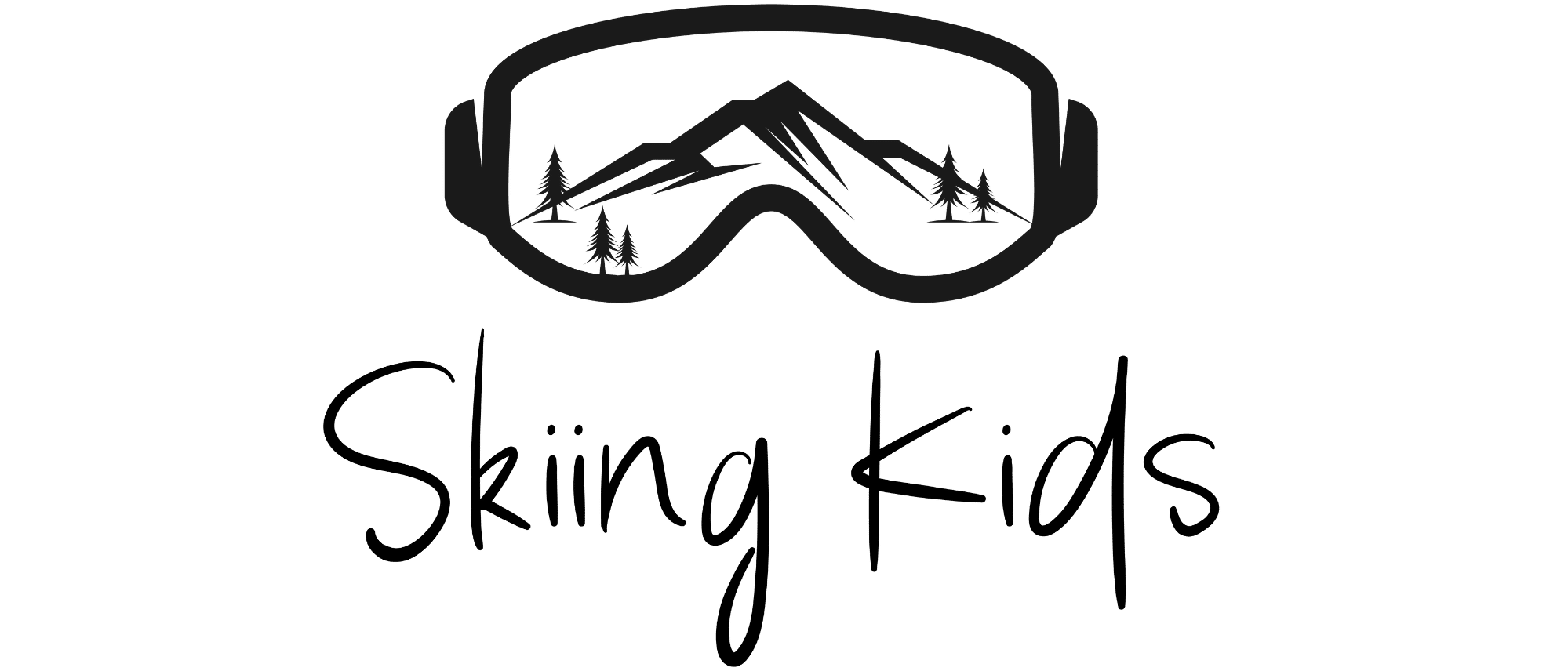This post may contain affiliate links where we earn from qualifying purchases from referring you to our favorite products and brands. As an amazon associate, we earn from qualifying purchases. Find out more in our disclosure.
As a ski mom, crowds on the slopes are one of my least favorite things about skiing. As much as we try to avoid ski crowds, sometimes you just can’t. Whether you’re dealing with holiday crowds or a local rush to ski some fresh powder, it’s important to know how to ski safely in a crowd AND how to teach your kids to ski safely.
I regularly ski solo with my 5 kids while my husband is working. That puts a lot of pressure on me to keep everyone safe and keep tabs on all the kids. When I was working as a ski instructor I learned lots of tricks to help manage a group while skiing in a crowd and some good tips on how to escape the crowds even while holiday skiing.
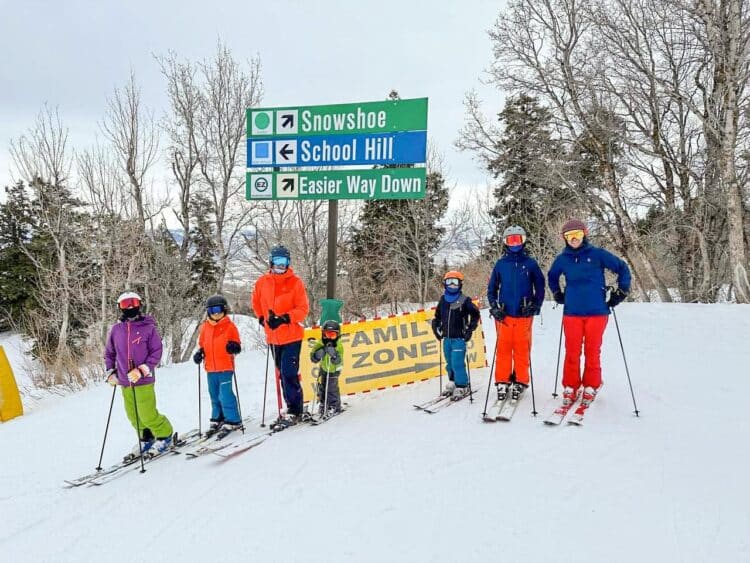
Wear Bright Clothing
Wearing bright clothing is my number one piece of advice for skiing when it’s crowded. Not only does bright clothing allow your friends and family to see you better, but it also makes you more visible to other skiers and riders on the mountain. For our younger kids, we make it a BIG priority to have them wear really bright clothing when we know it’s going to be a crowded ski day. That means bright outerwear and neon-colored helmets. Kids are naturally more difficult for adults to be aware of while skiing because they’re shorter. so we do everything possible to make our kids extra visible.
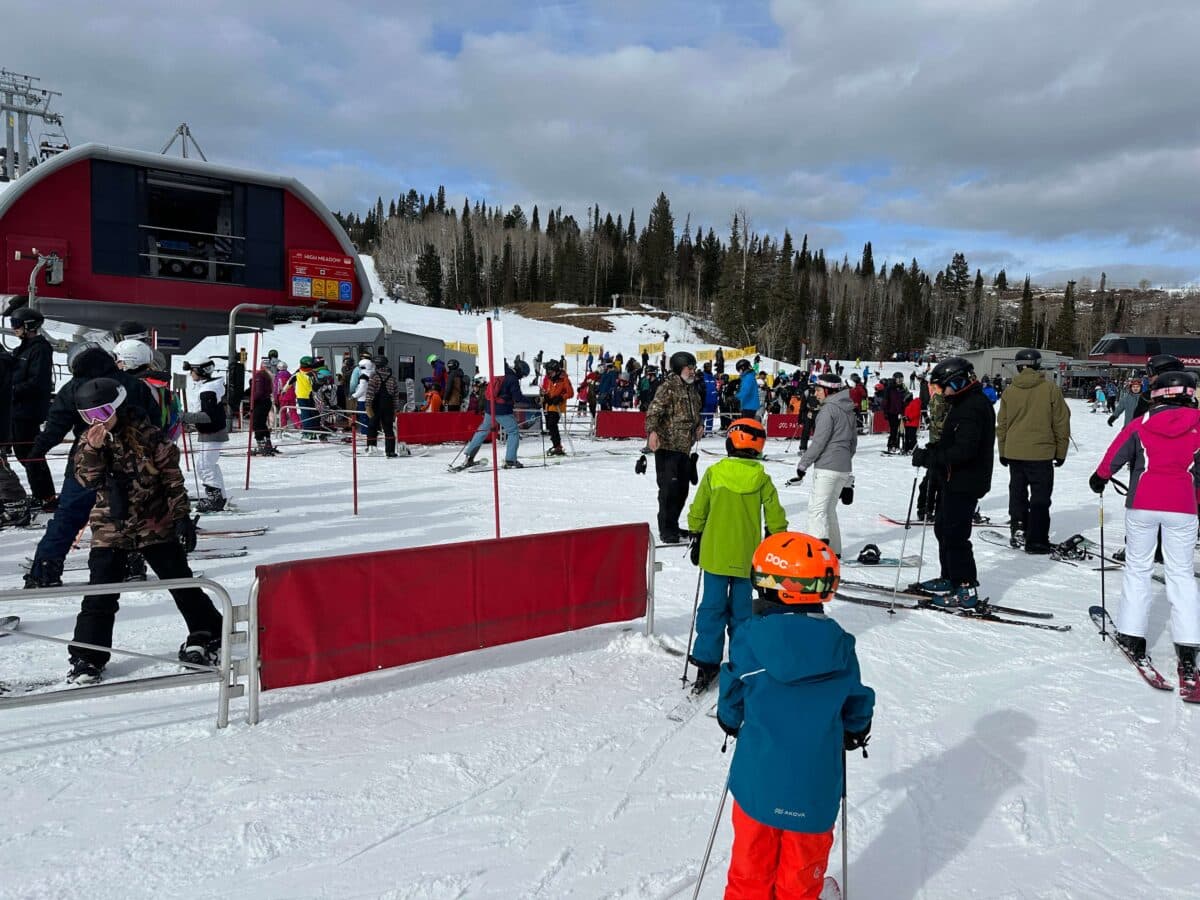
Always Wear a Helmet
The first essential piece of safety gear that everyone should be wearing is a helmet. Not only are helmets well proven to help prevent traumatic brain injuries but they prevent other head injuries as well. As a Utah local, it always amazes me that when we’re skiing during the holidays, I can almost always spot an out-of-town visitor by their lack of a helmet (and sometimes blue jeans…ack). There’s a common belief that if you’re a good enough skier, you won’t need a helmet, but that’s just not true. You never know when you’ll be hit by another skier or rider when going down the mountain. A few years ago, a helmet saved my son from major head injuries when he hit a tree while skiing.
Read: Best Kids Ski Helmets
The best way to prevent serious injuries is to make sure that everyone has a helmet that fits properly. Here are some tips to make sure your helmet fits right:
- Choose the Right Size: Start with choosing the right size. Measure the circumference of your head just above your eyebrows to get your size. (Note: Most helmet sizes are in centimeters). DO NOT size up so your child can wear their helmet longer.
- Positioning the Helmet: The helmet should sit level on your head, covering most of your forehead and not tilting back. There should be about two finger widths of space above your eyebrow to the helmet (the wearer’s finger size).
- Check the Fit:
- Snug but Comfortable: The helmet should feel snug around your head but not uncomfortably tight. It shouldn’t have any pressure points that cause discomfort.
- Shake Test: Gently shake your head from side to side and up and down. The helmet should stay in place and not wobble or slide around. If it shifts, it’s too loose.
- Check the Skin: When the helmet moves, your skin should move with it. If the helmet moves freely without moving the skin, it’s too big.
Helmets are designed to be worn on their own without a hat underneath, so if you have to put a hat on to get your helmet to fit, it doesn’t fit right.
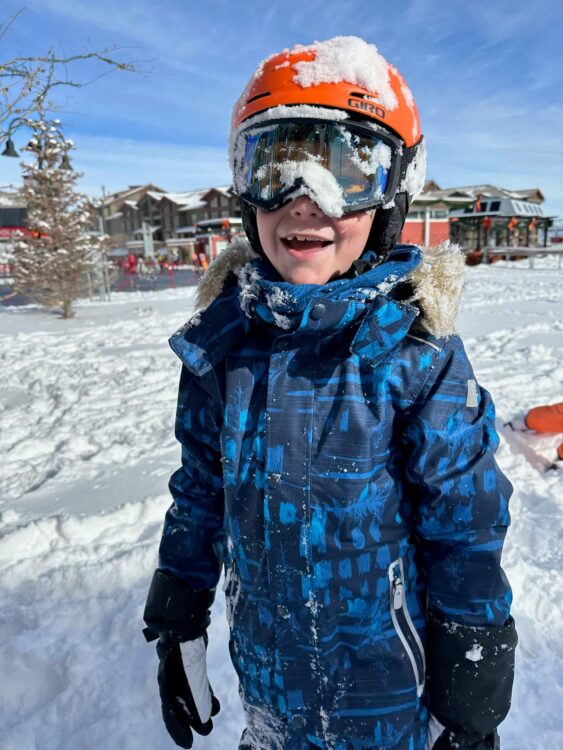
Always Stop on the Side of the Trail
When you need to stop, whether to rest or wait for others, always move to the side of the trail. Stopping in the middle can create a hazard for other skiers and snowboarders who may not see you in time or who don’t have the skills to avoid you. Teach this to children as a fundamental rule of ski etiquette. It’s also important to stop at the top of a hill, not just below it so you’re more visible to skiers from above. When stopping, look uphill to ensure it’s safe to move to the side. Once on the side, while you should be out of the way of most people, still be aware of skiers and riders around you. We are HUGE advocates of waiting and skiing together, so learning where to stop is an essential piece of ski safety.
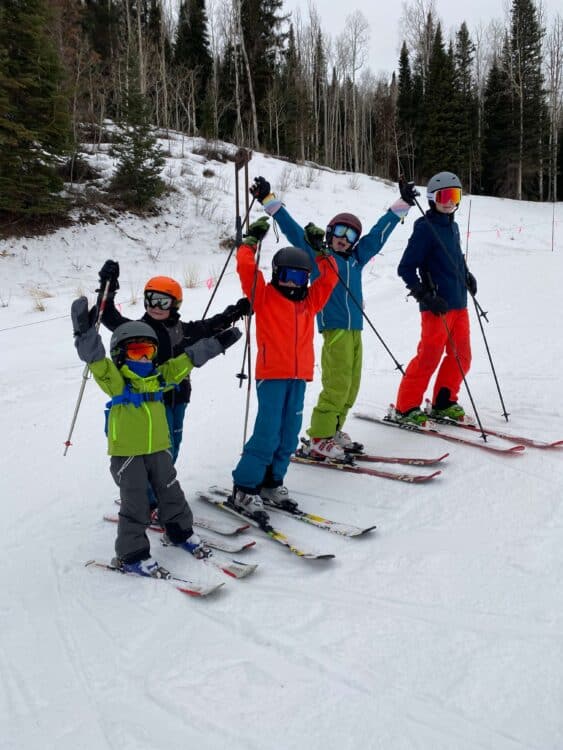
When Skiing In A Group, Stop and Wait For Everyone Multiple Times on Each Run
This goes right along with stopping on the side. Whether you’re skiing with 2 people or 10, making sure that you stop and wait for each other multiple times throughout the run is essential for ski safety. In our family, with our 5 kids, one of our mandatory rules is that the kids all stop and wait. On runs that we ski regularly, we have 3-4 stops designated where everyone stops and waits. When we’re skiing new terrain, we’ll usually just pick an easy-to-see spot farther down the hill and tell everyone to wait there, AND we have a rule that everyone stops when the trail splits so no one gets lost. While this does make your ski runs take longer, it’s significantly safer. Stopping and waiting ensures that if someone gets hurt or has a problem, you can quickly identify that and help them. Most often it’s the slowest and least experienced skiers who fall and lose a ski, or crash trying to ski over a jump. When the crowds are big, waiting is even more essential since it’s easy to get separated from the group. Waiting frequently ensures everyone’s safety, while still letting faster skiers have times when they can ski fast.
Note: In our family, when I say that waiting is non-negotiable, we mean it. If one of our kids doesn’t wait and they are just waiting at the bottom of the lift, our rule is that they sit out at least 1 run. We usually have 2-3 times that a kid forgets to wait early in the season, and after that, none of our 5 kids ever forget.
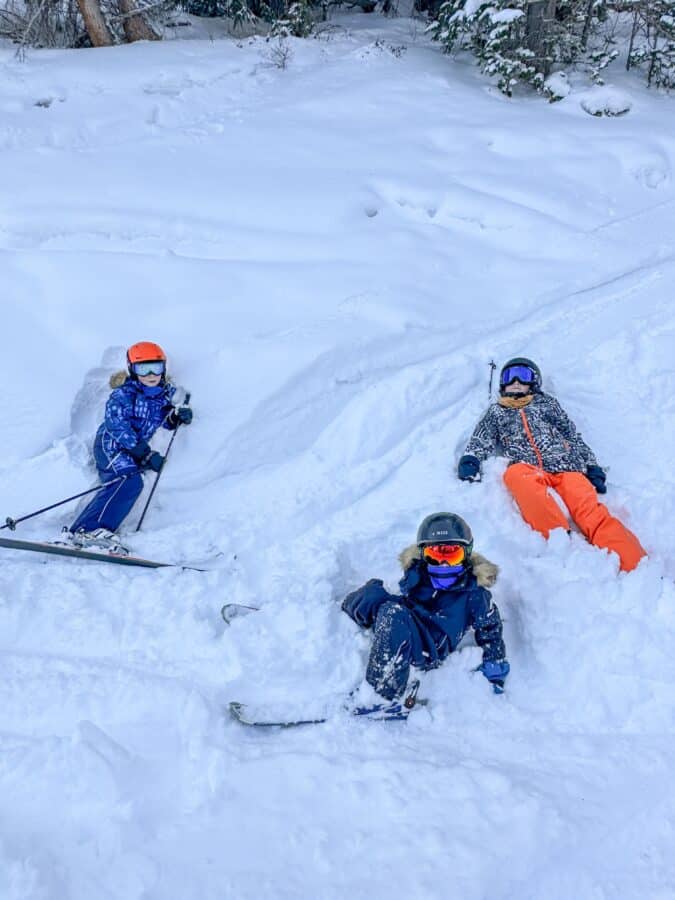
Designate a Meetup Area If People Get Separated
As hard as we try to keep everyone together, people sometimes get separated, and this happens most often on crowded days. Maybe they misunderstood where you said to wait, or they thought they were following right behind you, when in fact it was another skier who had gear that looked like yours (this is super common).
When we’re skiing with a group, we ALWAYS have a designated meet up spot. When kids are involved, we’ll point it out from several different runs so they know how to find it. Typically our meet up is at the bottom of the hill near a large landmark like a firepit or sculpture. We also tell our kids that if they’re separated from us and are waiting at our meet-up spot for more than 10 minutes, they should look around for ski patrol or mountain operations and tell them that they’re separated from their family.
DO NOT completely rely on cell phones to stay in touch while skiing. Cellular service in mountain areas can be horrible and most phone batteries don’t last long in cold weather.

Get There Early and Head Away From Crowded Main Runs Quickly
During times that we know that there will be lots of crowds, we plan to get to the ski hill extra early. Not only does that help us avoid traffic on the road, but it helps us avoid ski crowds too.
Our plan is always to get on the lift as soon after it opens as we can and head to the far corner of the resort. While it’s tempting to take a few fun laps when you first get to the hill, the crowds will quickly catch up with you. We explain this to the whole family so they know the plan and can manage their expectations.
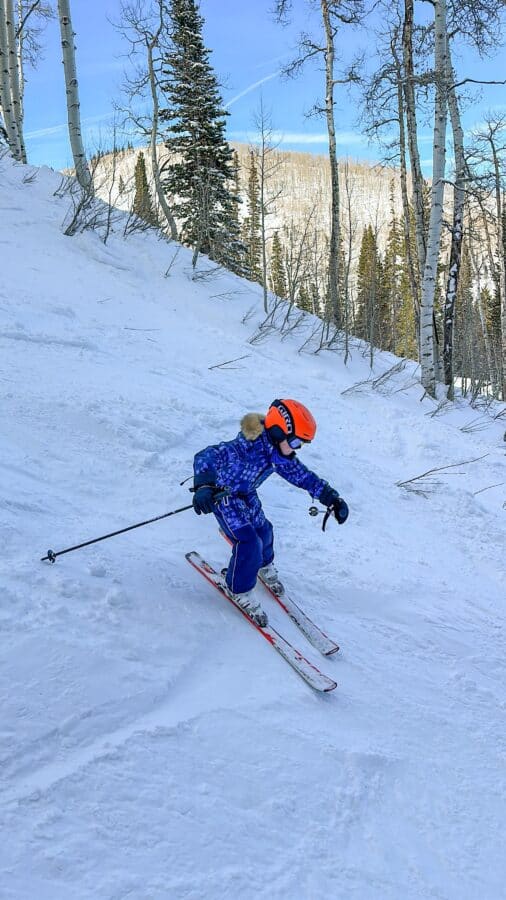
Learn to Identify and Avoid Out of Control Skiers and Riders
Being able to identify and steer clear of skiers and riders who are out of control is a really important skill to learn as you become a better skier. Teach everyone in your group to be aware of their surroundings and to watch for signs of erratic skiing or snowboarding. Something that works well for us is to point out out-of-control skiers from the lift and then have the kids identify what makes them out of control and how to avoid them. Things like changing your path early or stopping safely until they’ve passed are easy solutions that almost anyone can do. This awareness is especially important for children who may not recognize the dangers when they’re surrounded by lots of fast-skiing adults. Regularly practicing these observational skills is one of the best things you can do to stay safe while skiing in a crowd.

Have an Adult Ski Behind Young Kids
I want to shout this from the rooftops!! If you’re skiing in crowded conditions, ALWAYS have an adult ski behind younger kids (unless they don’t know how to turn yet). Little kids are often not seen by faster skiers and riders and can be easily hit. Truthfully, I can’t count the number of times that I’ve been skiing behind one of my kids and had someone clip my skis or crash into me – it’s happened dozens of times, regardless of the snow conditions. As an adult that’s pretty solid on my skis, most of these incidents didn’t do much damage to me, but they would have hurt a young kid pretty badly. If you want to avoid accidents that could be bad, try and stay between your child and other skiers to help your little one stay safe.

Look at a Map and Idenify Ski Run Bottlenecks and Try to Avoid Those
Before you start your ski trip, spend some time with the resort map. Identify potential bottlenecks on the runs, like narrow passages, intersections, or popular areas. Plan your routes to avoid these spots, especially during peak times. Knowing the layout of the resort helps you make informed decisions about which runs to take. This preparation can significantly reduce the chances of getting caught in crowded, potentially hazardous areas. Plus, exploring less-traveled paths often will give you better skiing too!
Follow the Skiers Responsibility Code
The Skier’s Responsibility Code is a set of safety tips intended to ensure safety on the slopes for both skiers and snowboarders. While there may be slight variations in wording from one ski area to another, the fundamental principles are generally the same. In some states, like Colorado, following the skiers responsibilty code is required by law. Here are the main points of the skiers code:
- Stay in Control: You must be able to stop or avoid other people or objects. This means skiing or snowboarding within your ability and adapting your speed and style to your skill level, the terrain, and the conditions on the mountain.
- Downhill Skiers and Riders Have the Right of Way: It is your responsibility to avoid people downhill from you. They may not be able to see you coming, so you need to be cautious and give them space.
- Stop in Safe Places: Avoid stopping in narrow areas or where you are not visible from above. If you need to stop, try to move to the side of the trail where you’re out of the way.
- Look Before You Ski: Whether entering a trail, starting downhill, or merging onto a new trail, always look uphill and yield to others. Make sure the way is clear before proceeding.
- Use Restraint Devices to Prevent Runaway Equipment: Make sure that any equipment that could become detached (like skis or snowboards) is secured in such a way that it won’t slide down the hill and cause a hazard for others. This is typically a snowboard leash and functioning ski brakes on your bindings.
- Observe Signs and Warnings: Stay out of closed trails and areas beyond the ski area boundary. Respect all signs and warnings, including boundary markers and slow skiing areas. They are there for your safety and the safety of others.
- Know How to Use Lifts Safely: Be familiar with how to load, ride, and unload lifts safely. If you’re not sure, ask a lift attendant for assistance (they’re usually super helpful, especially on beginner lifts).
- Stay out of Closed Terrain: Only ski on terrain that’s been opened by the ski resort. Going under ropes or past closed signs can put you at a significant risk since those areas are often not monitored or controlled my ski patrol.
- Assist in Case of Accidents: If you are involved in or witness a collision or accident, you should stay at the scene and identify yourself to the Ski Patrol. If there is no ski patrol around, exchange contact information with the person you collided with.
